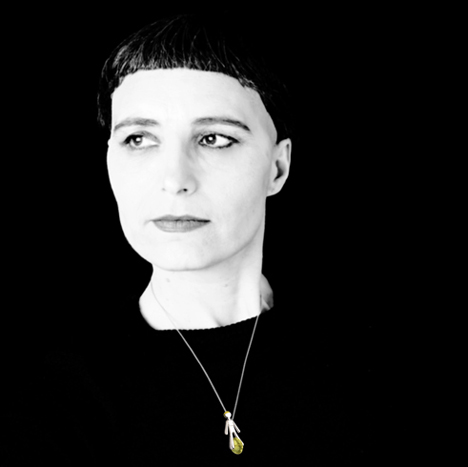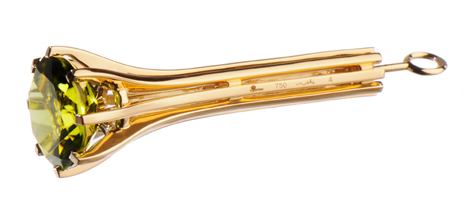
Le Buisson by Matali Crasset
French designer Matali Crasset has designed these jewellery pieces featuring tiny figures scuba diving, flying off with a jewel and perched on a unicycle.

Called Le Buisson, the designs are made of made of white gold and enamel, and have jewels that rotate round a pivot for the wearer to fiddle with.

Other designs depict a torch and equaliser lights on a stereo.

The project was initiated by jewellers Le Buisson, created when the founders' friend wanted to melt down all her jewellery and have it remade to symbolically wipe out her past at the end of a love affair.

Matali Crasset was selected along with Petra Mrzyk & Jean François Moriceau and Geneviève Gauckler to design the new pieces.

Photographer Aurelien Mole had photographed Crasset wearing the jewellery in a photo shoot inspired by the style of 1920s actress Louise Brooks.


Here are some more details from Matali Crasset:
Le Buisson – jeweller Paris
One day, after a great deception in love, a women decided to melt down all her jewellery. This meant putting the past behind her from now on, to start again from nothing. Did not Genesis tell us that when the world was created, there was nothing but chaos and confusion? Did not the alchemist in olden times start his work by purifying his metals in the Athanor, the original crucible? In this way, by melting down her jewellery, she started her new life.

But everything had to be picked up again, everything reinvented. It therefore started with the jewellery, that would be re-examined from top to bottom. The person who would follow up this baroque idea had to be found. She called on her artist or designer friends. They never wore jewellery, they had never made them. So they were perfect. The idea in fact was to design jewellery for someone who was not accustomed to it.

Jewellery not made to be shown off on special occasions but to please, on a daily basis. They wanted fine jewellery in gold, enhanced with diamonds, amethysts or opals, but that are not ostentatious. Jewellery which would combine formal invention, the quality of the materials and the demands of craft know-how. In this way, Le Buisson came into being, the jewellery publishers. This small group wanted to work similarly to the most demanding literary publishers: authors, designers of forms internationally known in their respective fields, who would be given a free hand; and one would work with them on original collections of jewellery, supervising all the stages in the design and manufacture of the pieces.

The first designers contacted were immediately attracted by the project. They voluntarily took the opposite view to the luxury jewellers’ traditional codes, without proposing pieces impossible to make or which would never be worn. The ratio between the gold mass and the number of stones, the visible and the hidden, the setting methods, everything was thought out and were so many technical challengers for the jewellery craftsmen. They invented a new type of jewellery, unique and joyful, precious and discreet. Pieces which sent out less of a message on social success than the benign waves of contemporary talismans.

The pieces of jewellery are more than symbols of wealth or rare and precious objects. Since prehistoric times, they have had a symbolic force. For a long time, it was the material that gave them this strength: the purity of the gold, a solar and divine metal, the benign virtue of the gems or the resistance of horn and ivory passed on by contact with the wearer of the set. Then the jewel slowly lost its tactile and magic effect to become more ostentatious, and more and more a very visible sign of vanity.

The Le Buisson jewellery is going back to jewellery’s origins. They do not imitate the shapes of old amulets, they draw on contemporary imagination for another way of reflecting on the timeless functions of the set of jewels. Objects to be touched as much as looked at, they are today’s charms. They combine humour and simplicity, formal invention and perfection in creation. Luxurious, they remain simple and elegant. They are intelligent and joyful pie- ces of jewellery which can be worn without affectation. They show a varied range of designs and moods, for men and for women. The only things they have in common are the originality of the design and the perfect quality of the production.

Matali Crasset

The Equaliseur and Torch play somewhat on light effects. In this case, it does not mean sunlight but electric light treated with subtle irony. The equaliser’s potentiometers, symbol of the 1980’s high- tech, becomes a sort of abstract stain-glass window bringing to mind the minimal paintings of an Ellsworth Kelly. The Torch setting forms the framework of the object which allows the profile to be seen, and not the front which is normal, the amethyst or the diamond. So that a slightly enigmatic radiance runs around the pendant.
See also:
.
 |
 |
 |
| Essentials II by Patrik Muff for Nymphenburg |
Jointed Jewels by Alissia Melka-Teichroew |
Charming by Tord Boontje |